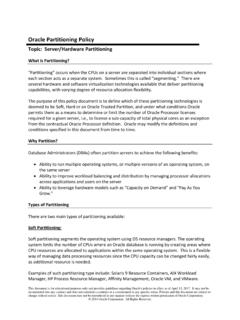Transcription of Oracle to DB2 Database Migration: Lessons Learned
1 Oracle to DB2 migration : Lessons Learned Page 1 Oracle to DB2 Database migration : Lessons Learned Frank C. Fillmore, Jr.; Principal and Founder, The Fillmore Group Executive Summary Vendor lock-in is a hidden, but tangible cost associated with ongoing deployment of information technology (IT) infrastructure. Expensive annual software maintenance charges and high operational costs of Oracle databases are compelling reasons to overcome this particular vendor lock-in. IBM s enablement of Oracle PL/SQL application programming interfaces (APIs) in their flagship DB2 Database has been exploited by over 1,0001 customers to migrate applications from Oracle to DB2. While the primary motivator is financial, there are a number of ancillary benefits accruing to such a move: server consolidation, operational efficiencies, continuous Database availability, fault tolerance, and better performance. Overview In these challenging times, most organizations are looking for a competitive edge.
2 Reducing expenses and increasing agility are two ways enterprises of all types seek to carve out market opportunities and establish reliable, resilient platforms for sustained future growth. Many IT business units are resigned to tolerating vendor choices made many years ago by colleagues who might be long gone. One key choice has always been: which relational Database management system (RDBMS) should they use for online transaction processing (OLTP), online analytical processing (OLAP), data warehousing, data mining, business analytics, and other related processes? Business and technology developments in the RDBMS vendor space raise this vital question today for many Oracle shops. The purpose of this White Paper is to detail the business and operational advantages of switching RDBMS platforms from Oracle to DB2. Interwoven with a generalized discussion will be specific examples derived from a large-scale conversion project for a worldwide Top-50 financial institution which migrated a mission-critical application from Oracle to DB2 in 2011.
3 Oracle to DB2 migration : Lessons Learned Page 2 Benefits of Migrating to DB2 The primary benefit is financial: DB2 Advanced Enterprise Server Edition (AESE) can be as low as 1/3 the cost of Oracle2. The next set of benefits are quantitative DB2 required fewer of everything for this particular client: Thirty-six(36) Sun servers reduced to four(4) POWER 770 servers3 for multiple application databases. Fewer servers resulted in fewer instances of DB2 to license. Twenty-seven(27) full-time equivalency (FTE) staff positions reduced to twelve(12) FTE for all migrated databases. Surplus staff members were redeployed to other tasks. Additional benefits are qualitative: DB2 High Availability Disaster Recovery (HADR) provides Database level failover at data centers 14 miles apart; the customer impact of a Database switchover between datacenters under load is 15 seconds, with an automatic cutover of application connections. The client repeatedly had tried without success to implement Oracle Real Application Clusters (RAC) with Data Guard to enable Oracle high availability.
4 The ability to switchover with efficiency is now a valuable triage tool that has significantly improved [our] mean time to recover from application anomalies. It is now customary [for us] to initiate a datacenter Database switch to attempt to clear customer impacting locks, slowdowns, and hung threads that previously required a restart during off hours. Database switching in this manner was unanticipated and noteworthy. 4 IBM transaction-level Q Replication provides tertiary failover 500 miles from primary/secondary data centers. In 2010 Oracle block-level replication had transmitted corrupted log records to all failover sites. Database recovery took days resulting in a major, high-visibility customer-facing application outage. DB2 on POWER delivers up to 3 times the performance per core of Oracle Database on SPARC5. The client anecdotally indicated that IBM DB2 technical support was more responsive and able to address and resolve issues more quickly than did Oracle .
5 Oracle to DB2 migration : Lessons Learned Page 3 IBM has a series of tools to evaluate and enable a migration from Oracle to DB2: migration Enablement Evaluation Tool (MEET) to make a detailed determination of an existing Oracle Database s compatibility with DB26. Business Value Assessment (BVA) financial tool to compare current Oracle licensing costs to equivalent DB2 licensing costs. IBM Data Movement Tool (IDMT) to extract data and Database objects from an Oracle Database and load them into DB27. Contact your IBM representative or IBM Business Partner for additional information regarding these tools and to receive a free review of your Oracle Database and workload suitability for migration to DB2. Oracle to DB2 migration : Lessons Learned Page 4 Key Players in the migration Process Once a choice has been made to consider migrating from Oracle to DB2, who should be involved? And when? The following table lists the various contributors and when they participate in the process.
6 Decision Planning/Design Implementation Testing LOB executives X IT executives X Data/Application Architects X X X X Database Administrators X X X Systems Administrators X X X Application developers X X End users X IT and line-of-business (LOB) executives must collaborate on determining the overall value to the organization of migrating from Oracle , the impact a major infrastructure change will have on new feature/function application development delivery schedules, and most importantly the return on investment of choosing to move to DB2. Commitment from both IT and LOB executives is crucial to the success of such an undertaking. Data and application architects are the only role which spans all phases of a migration project. It is important that architects provide to senior executives validation that a migration is technically feasible, then shepherd the process from a go decision to production cutover and beyond. Some might argue that Database administrators (DBAs) should be included in the decision to migrate and application developers in the planning.
7 One practical aspect of this process that must be considered is that Oracle DBAs and developers will be asked to make a major change that some might deem to be detrimental to their careers. Most IT professionals take pride in their skills and develop a loyalty to the products with which they have worked for years. In several instances where clients have contemplated a migration from Oracle to DB2, the in-the-trenches influencers have not unreasonably focused on their perceived career interests rather than the goals and objectives of their employer. Better to make the decision on the financial and technical merits and include other stakeholders as the need arises. An alternative approach is offer financial incentives and retention bonuses to key technical staff members. In this way they can share in the benefits of the migration and mitigate any perceived risk. Oracle to DB2 migration : Lessons Learned Page 5 Planning and Designing the Migration8 It is prudent to view changing Database software within the larger context of an organization s IT infrastructure.
8 While a client could just migrate from Oracle to DB2 and keep all other infrastructure components ( server hardware, operating system, storage, networking, facilities, etc.), the current state of those components such as capacity, projected useful life, and other factors should be considered as well. In the case of the Top-50 financial institution, they changed virtually every aspect of their IT infrastructure. There were two reasons: most of the existing infrastructure was outdated and they wanted to exploit synergies between IBM hardware and middleware. For example: DB2 can exploit an AIX 16 MB page size on IBM POWER systems; for memory-intensive Database applications, this can dramatically improve performance. New infrastructure also insulates existing application workloads from the migration process. It is important to note however, that migrating from Oracle to DB2 does not require any other changes if existing hardware and operating systems are compliant with DB2 prerequisites.
9 Design of the new Database servers should incorporate existing service-level agreements (SLAs) for OLTP, business analytics, and other Database -dependant processes. They should also sustain projected growth in demand and capacity, whether organic or through mergers and acquisitions. IBM s Smart Analytics System (ISAS)9 is a DB2 Database platform which delivers optimized, integrated hardware, software, and storage. ISAS mitigates the risk of incorrectly forecasting future Database utilization by providing preconfigured units of additional capacity for all components. Application and Data migration While up to 98% of a typical client s Oracle PL/SQL workload will run unmodified against a DB2 database10, application source code will need to be managed through the migration process to accommodate changes for the other 2% of PL/SQL which is not supported by the DB2 APIs to improve performance to incorporate functional enhancements, comply with legal requirements, and meet other business objectives that arise during the migration .
10 The migration from one Database platform to another doesn t occur in a vacuum and a rapidly changing competitive and regulatory environment won t permit a code freeze . Application source code, RDBMS Data Definition Language (DDL), batch scripts, and other artifacts should be managed by repository tools that support versioning and multiple user check-in/check-out access. Oracle to DB2 migration : Lessons Learned Page 6 Data migration is enabled by the IDMT referenced earlier. Through a command line interface or GUI, the no-cost IDMT automates the extraction of Oracle data and DDL and generates DB2 LOAD utility scripts. The Top-50 financial institution used IDMT for all of its migration activity. IDMT, by its nature, is a batch process and must be benchmarked. The elapsed time of extract and load for one of the client s multi-terabyte OLTP databases was measured at approximately five days. Sustaining a five-day outage for this particular application was not feasible, so they used a combination of IDMT and IBM s Q Replication software (to capture Oracle transactions while IDMT was running) to significantly reduce the outage window11.







